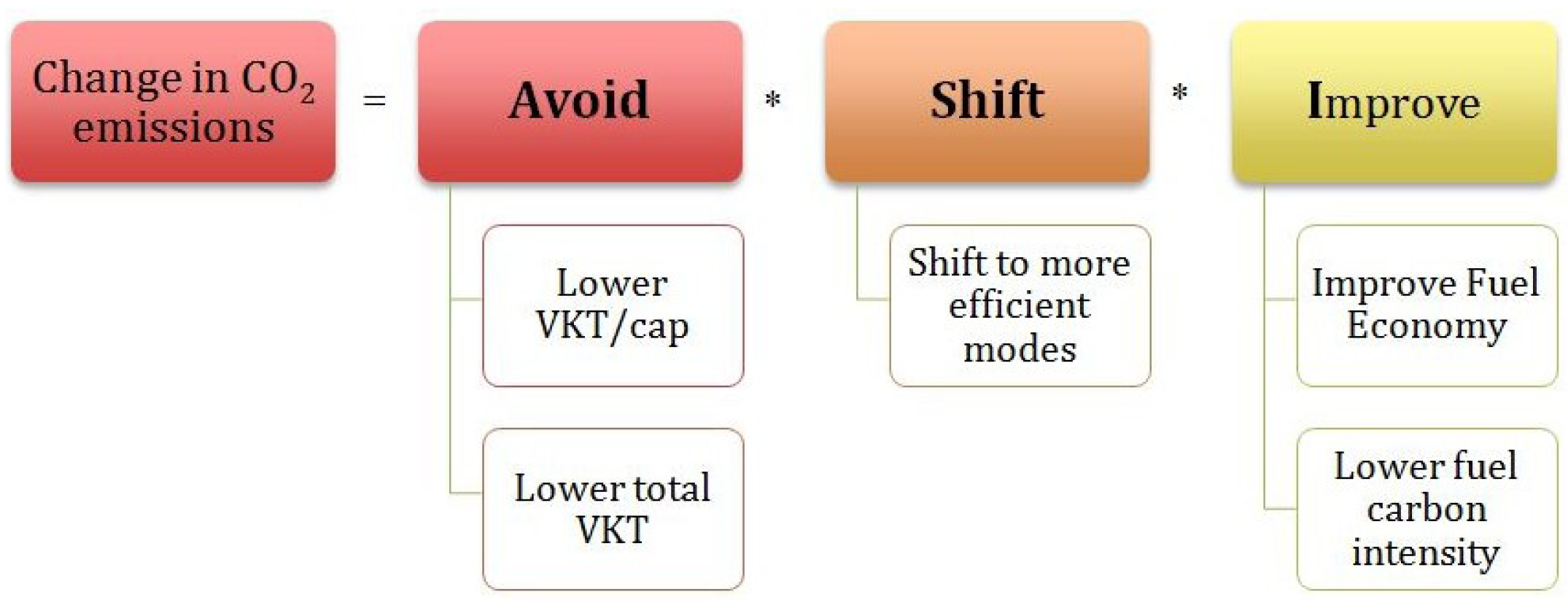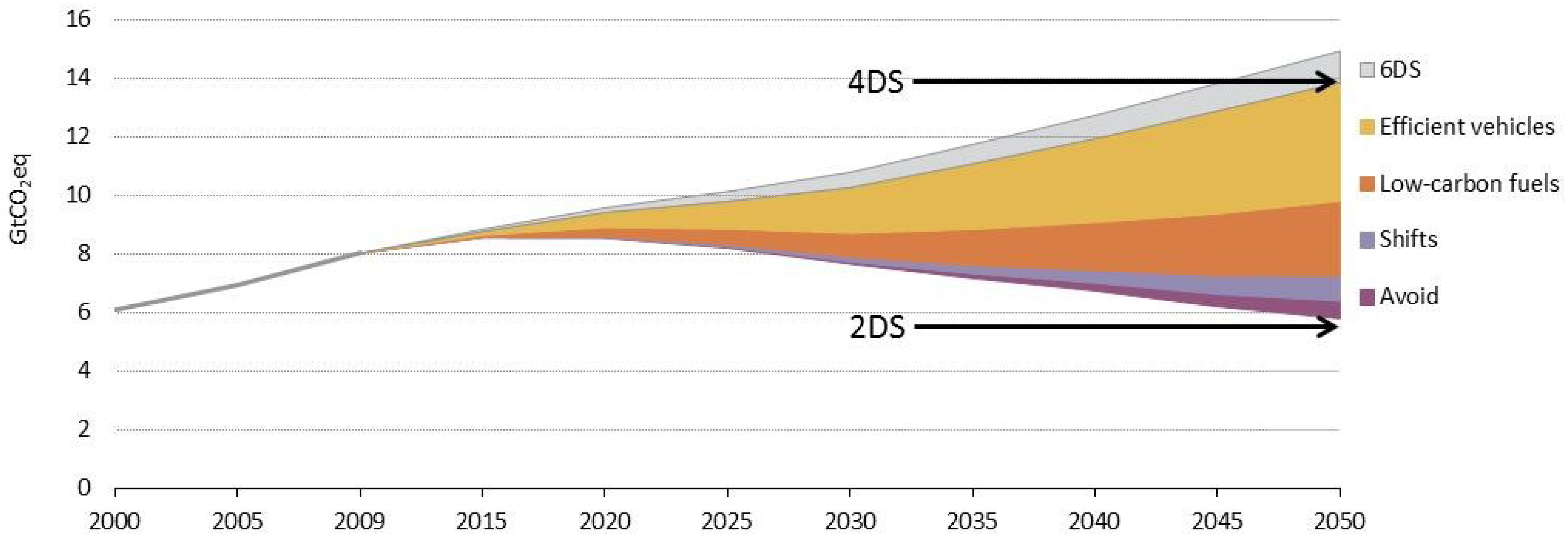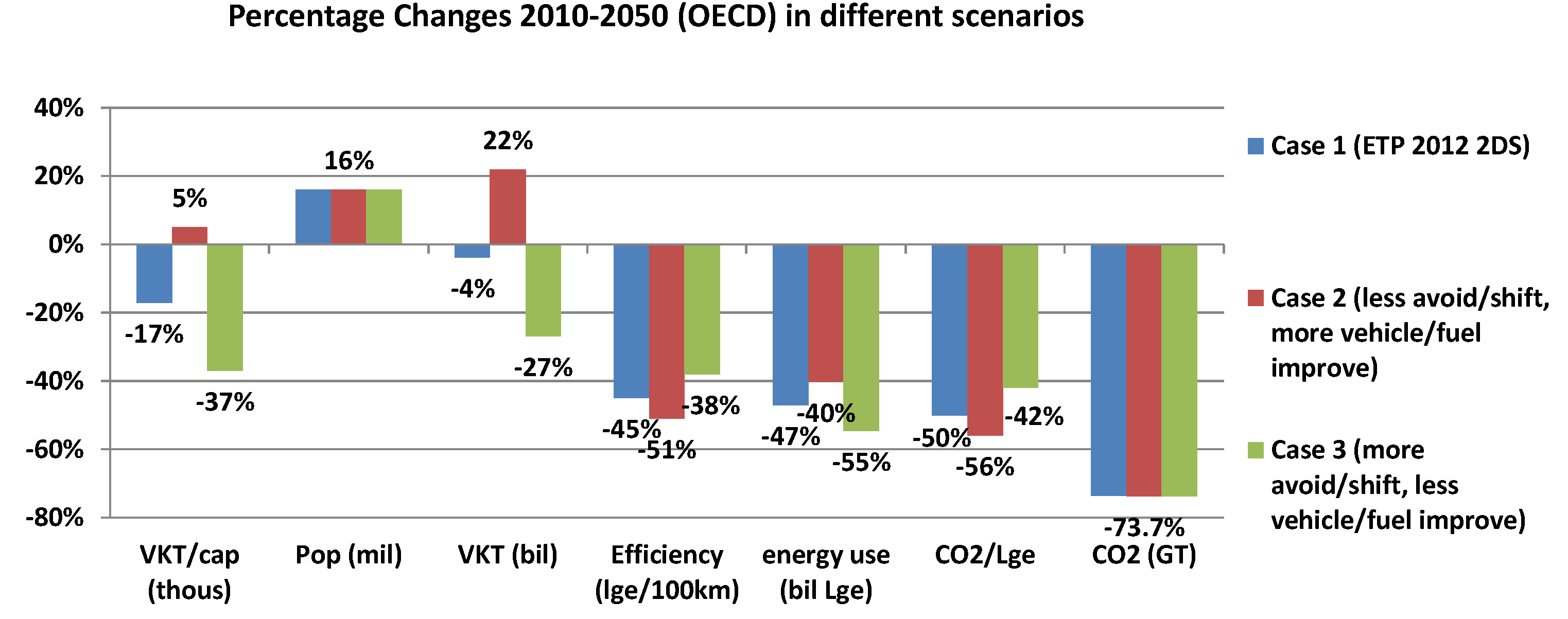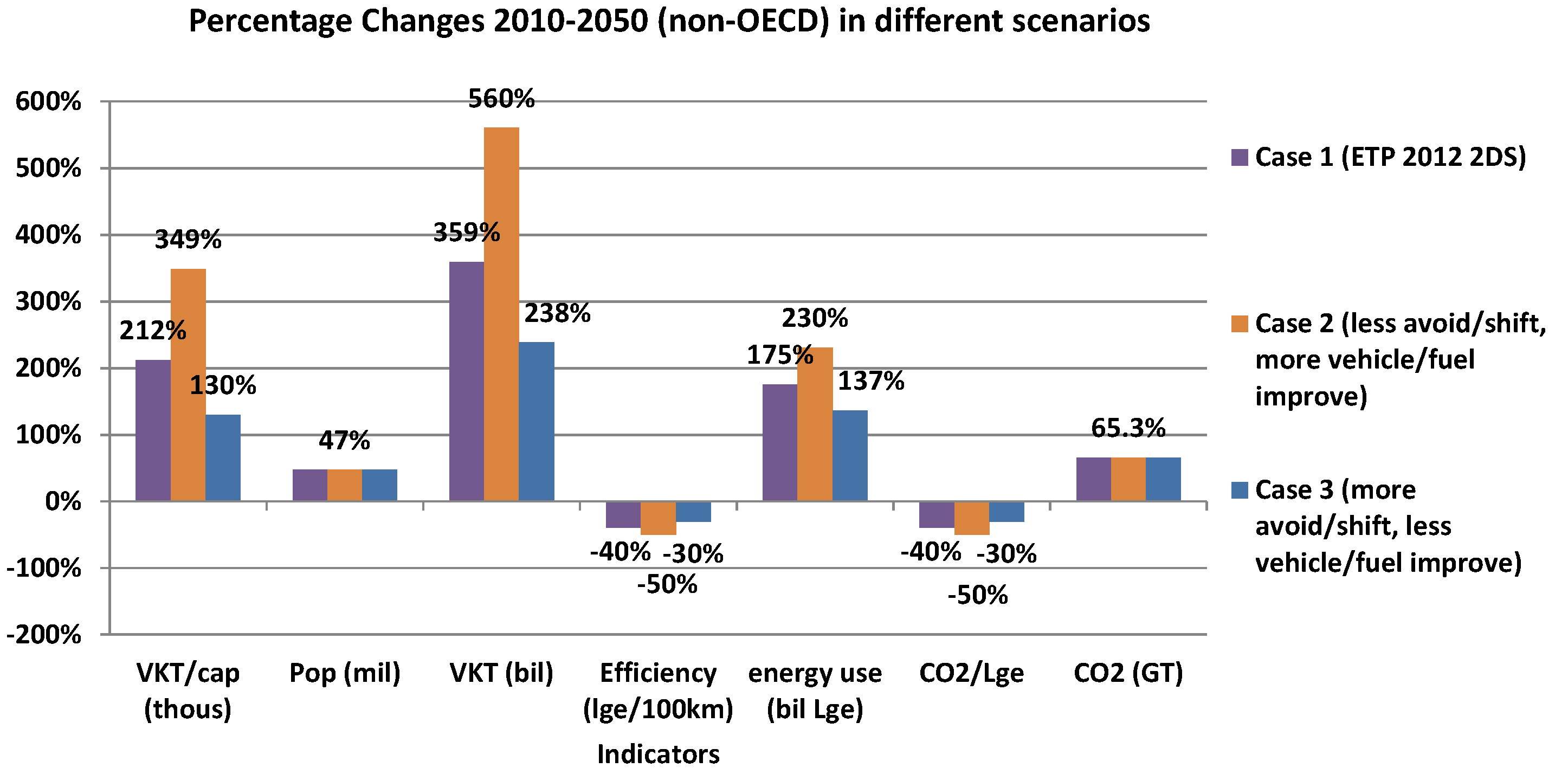This section will build on the ETP 2012 scenario and will explore the results of the two sensitivity cases that have been developed to show the relevance of the required fuel switch and efficiency improvements under different travel growth and modal share projections in OECD and non-OECD countries. This will help highlighting the complementarity of Avoid/Shift and Improve measures for climate change mitigation strategies over the coming decades.
3.1. Three Different Pathways towards a 2° Goal: Two Sensitivity Cases Building on the ETP 2012 2° Scenario
Based on the ETP 2012 2° scenario (Case 1, ETP 2012 2DS) two sensitivity cases have been developed (Case 2, less avoid/shift, more vehicle/fuel improve, and Case 3, more avoid/shift, less vehicle/fuel improve) to disentangle the required fuel switch and efficiency gains changes in travel and determining the necessary changes in vehicles/fuels to reach a given CO2 reduction target. For all three cases constant assumptions on population and economic growth have been used. This sensitivity analysis has been developed for OECD and non-OECD countries to highlight the different development pathways.
In the OECD countries the ETP 2012 2DS projection sees a 17% reduction in light-duty vehicle travel per capita between 2010 and 2050 (
Figure 5). This assumes that even though the population grows, total travel in industrialized countries is decreasing by 4%, which would be a substantial deviation from the current path. This change in travel is accompanied by a 45% average improvement in vehicle efficiency (reduction in energy/km) to achieve a 47% reduction in energy use. To achieve the desired reduction of 73% (The emission reduction target of 73% has been adopted for the ETP 2012 to be in line with an emission reduction pathway for a 2° stabilization scenario as suggested by the IPCC [
8].) in light vehicle well to wheel CO
2 emissions, the ETP 2DS case further assumes a 50% reduction in the carbon intensity of the energy (via shifts to electricity, hydrogen, and biofuels).
The sensitivity case 2 shows what would happen if the reality with regard to reduced travel and modal shift (avoid/shift) fall short of the assumptions made in the ETP 2DS case. The Case 2 uses the travel projections assumed for the ETP 4° scenario, which are a 5% growth per capita and 22% overall between 2010 and 2050. Under these conditions, additional efficiency gains and fuel carbon reductions are required to meet the CO
2 emission reduction target of 73% for the light vehicle fleet in OECD countries. As shown in
Figure 5, this could be achieved by improving on-road vehicle efficiency (lower energy/km) by 51% instead of 45% over the 40-year period, combined with reducing fuel carbon intensity (emissions per unit energy) by a similar additional proportion, by 56% instead of 50%.
Figure 5.
Light vehicle fleet scenarios until 2050 in OECD countries.
Figure 5.
Light vehicle fleet scenarios until 2050 in OECD countries.
The other sensitivity case shows what happens if car travel per capita could be reduced by even more than the 2DS case. Case 3 shows the effects of additional reductions leading to a 37% drop of car travel between 2010 and 2050. While this would require very strong policies and investments to reduce travel and shift towards public transport and non-motorized transport, efficiency would only need to improve by 38% instead of 45% and a 42% drop in fuel carbon intensity instead of 50% compared to the 2DS case.
Figure 6 shows these same cases for non-OECD countries. The results are similar despite a very different underlying situation. In developing and emerging countries, light-vehicle travel per capita triples in 2DS case while fuel efficiency and carbon intensity both improve by 40%, leading to a net increase in CO
2 of 65% by 2050. Considering that emissions in non-OECD countries would more than tripling without any major additional mitigation strategies, this would be a substantial reduction from the baseline. The two sensitivity cases aim to achieve the same target via different approaches. Case 2 allows for travel growth, which means that efficiency and fuel carbon will have to improve by 50% instead of 40%. The lower growth in car travel achieved through sustained high levels of public and non-motorized transport in Case 3 requires lower efficiency and fuel switch, at 30% instead of 40%.
Figure 6.
Light vehicle fleet scenarios until 2050 in non-OECD countries.
Figure 6.
Light vehicle fleet scenarios until 2050 in non-OECD countries.
For both OECD and non-OECD countries, not achieving the car travel paths used for the 2DS case, would mean that vehicle fuel efficiency and fuel carbon intensity will have to be improved to levels that may be challenging, both from a technology and cost-effectiveness perspective [
9]. However, the modal shifts and travel reductions assumed in Case 3 may be equally challenging, which clearly indicates that an integrated approach will be required that combines avoid, shift and improve measures.
3.2. The Implications of Different Travel Demand and Modal Share Assumptions on Vehicle Technologies and Fuels
Considerable analysis is needed of policy implications, private and social costs, and the wide range of impacts and sustainability implications of different pathways. However, the high level assessment of the three cases compared in this paper already provides some interesting insights on the relationship of avoid, shift and improve measures.
Comparing cases 2 and 3 (the high travel and low car travel sensitivity cases), the requirement for additional fuel efficiency improvements and reductions in vehicle stock energy intensity as explored in the previous section reach levels where cost-effectiveness may become challenging. The significant additional amount of efficiency gains of 13% in OECD countries and even 20% in non-OECD countries represents a range of fuel economy improvements that may become steadily more difficult and costlier. A number of studies have developed cost curves for light duty vehicle fuel economy (e.g., NRC, 2010, ICCT, 2011), summarized by the IEA in its Fuel Economy Roadmap [
9]. It finds that, if undertaken today, it would cost an extra €4,000 (USD5,000) per vehicle to move from a 45% to a 60% improvement, compared to around €2,000 to reach the initial 45% improvement. This reflects the upward concavity of the cost curve and increasing marginal cost of technologies to improve fuel economy. The technologies that are deployed start with relatively low cost changes such as 4-valve HDI fuel injection, and eventually move toward adoption of hybridization and expensive light-weight materials. Efficiency improvements can also be achieved through a shift to plug-in vehicles (battery-electric vehicles, plug-in hybrid electric vehicles), likely to be even more efficient than advanced hybrids when running on electricity and electric motors. But the costs of these vehicles will be even higher than advanced conventional vehicles and hybrids, at least in the near term.
It should be noted, however, that over time the costs of advanced efficiency technologies and plug-in technologies will likely decrease, given technology advances and economies of scale, and by 2030 could be well less than the costs for current changes [
9,
10]. None-the-less, the cost of marginal efficiency improvements between 40 and 60% may remain be over €3,000 (USD4,000) in the near-medium term [
9,
10,
11]. This is likely to hold for both OECD and non-OECD, since the technologies are likely to be similar.
The CO
2 intensity of fuels can be improved through a combination of uptake of plug-in vehicles, fuel cell vehicles and their new fuels, electricity and hydrogen respectively [
1,
6]. Advanced biofuels can also play an important role in reducing average fuel carbon intensity. However, all of these technologies and fuels are quite expensive today and associated with a number of uncertainties, which may help to explain why they are not yet fully commercial, though sales of electric vehicles have increased rapidly in the past two years [
1]. Attempting to estimate how the cost of deploying these new vehicles and fuels will change over the next two decades, and in particular how costs may change in the range of sales that reduces average CO
2 intensity from 40% to 60%, is quite speculative [
9,
10,
11]. Hence, strategies that heavily rely on advanced technologies and fuels contain a higher level of risks and uncertainties.
Figure 7a,b illustrate the changes in sales and market shares of advanced technology vehicles that occur in 2DS case compared to the two sensitivity cases developed (Low Avoid/Shift, and High Avoid/Shift) through 2050. It shows how the sales share of these technologies would need to change in the higher and lower car travel cases to meet the combined CO
2 emission reduction target for both, OECD and non-OECD countries. In the ETP 2DS, new technology vehicles such as plug-in hybrid (PHEV), battery electric vehicle (BEV) and fuel cell vehicles (FCEV) will have to increase their market shares very rapidly after 2030 to achieve a high combined share by 2050 and provide both efficiency improvements and fuel carbon reductions (
Figure 7a).
Figure 7b shows these three plug-in vehicle types together in the three different cases; in the 2DS it can be seen that these reach over 75% market share in 2050, and even by 2035 they reach about 45% of global light-duty vehicles (LDV) sales. In the Low and High Avoid/Shift cases, the sales share ranges from 50% to 100% of new LDVs in 2050, and 30% to 60% in 2035. These are very significant differences, which suggests that the Low Avoid/Shift and High Improve case would require much faster market penetration rates, while the and High Avoid/Shift and Low Improve case would compensate for slower progress in technology uptake.
Figure 7.
New technology light-duty vehicle (LDV) sales in 2-degree scenario (2DS) (a) and combined (battery electric vehicle (BEV) + plug-in hybrid vehicle (PHEV) + Fuel cell) sales share in three cases (b).
Figure 7.
New technology light-duty vehicle (LDV) sales in 2-degree scenario (2DS) (a) and combined (battery electric vehicle (BEV) + plug-in hybrid vehicle (PHEV) + Fuel cell) sales share in three cases (b).
Figure 8a below shows the well-to-wheel (WTW) carbon intensity (CO
2 per MJ) of the major fuels in the 2DS case, along with the weighted average fuel intensity based on the consumption of the different fuels. This corresponds to the vehicle technology sales shares explored in
Figure 7. Although biofuels help bend the curve for liquid fuels somewhat, the increasing use of electricity and hydrogen in plug-in and fuel cell vehicles serve to strongly decrease the average LDV fuel carbon intensity after 2035, when these vehicles and fuels have reached substantial market shares (
Figure 8a). This is also shown in
Figure 8b as the middle line, which clearly shows a drop in CO
2 g/MJ from 70 in 2030 to 40 in 2050, providing a direct reduction in CO
2 intensity of nearly 50%.
Figure 8b also shows the two alternative cases, and the effect of the additional advanced technology vehicles in the High Improve case, and the fewer vehicles in the Low Improve case. The difference in average fuel intensity ranges from 45 to 35 CO
2. An additional reduction in CO
2 intensity comes from on-going required increases in biofuel share. In the 2DS case, this reaches about 30% of the liquid fuels share, and is increased to about 40% in the Low Avoid/Shift and High Improve case in order to bring the overall fuel carbon intensity down to the target level (not reflected in this figure).
Figure 8.
LDV Fuel Carbon Intensity in 2DS (a) and weighted average intensity in all three cases (b).
Figure 8.
LDV Fuel Carbon Intensity in 2DS (a) and weighted average intensity in all three cases (b).
While it is difficult to assess how the three cases compare with regard to their cost-effectiveness and technological and political feasibility over time, it becomes apparent that a combined approach as suggested in the 2DS case, potentially with an even stronger focus on Avoid/Shift measures may be required. A larger role for technology and fuels than suggested in the ETP 2012 2DS case may require a substantial boost in the transition toward low-carbon vehicles and fuels, which may become very challenging in terms of investment rates into new production systems and consumer acceptance of new types of vehicles and fuels. It will take additional analysis to better estimate the actual costs and benefits in these scenarios and attempt to quantify the level of policy stringency that may be needed to achieve them, but it seems clear that both sensitivity cases would require strong policy packages to foster modal shift, reduce travel demand and/or boost fuel efficiency and technology take-up, compared to a more balanced approach as explored in the IEA ETP 2012 2DS case.












